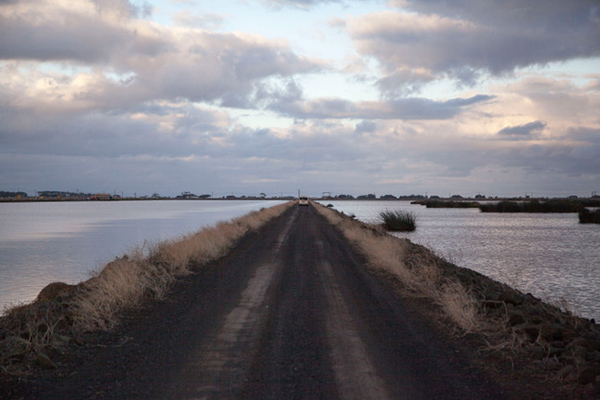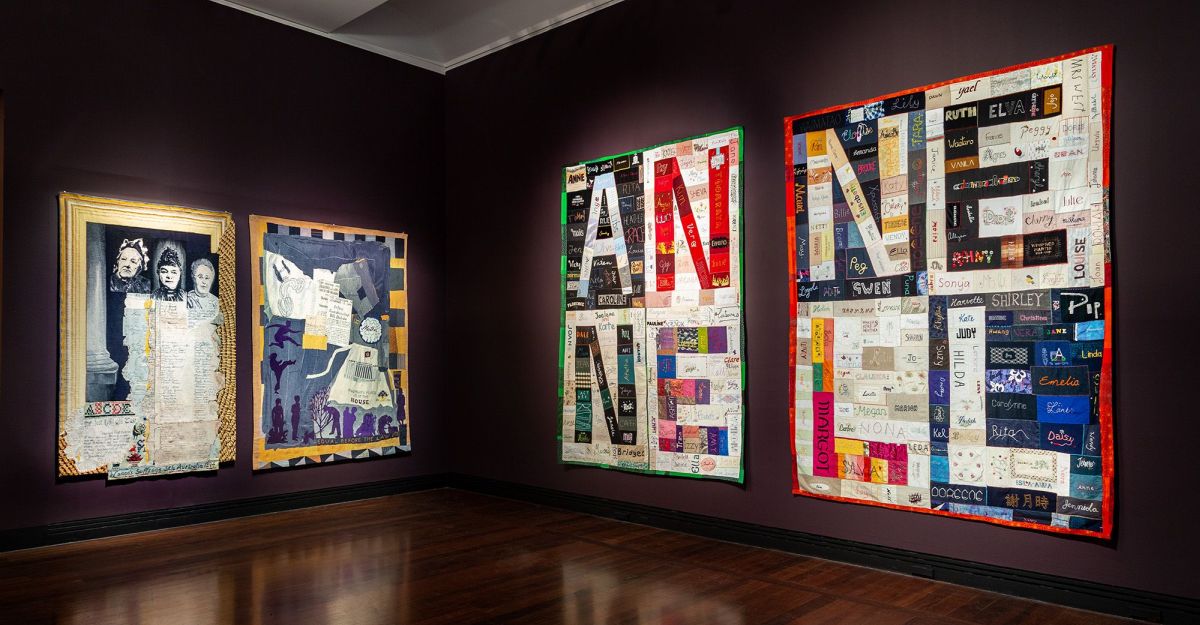If someone told me a visit to the Western Treatment Plant, where half of Melbourne’s sewage is treated, would lead me to contemplate the Anthropocene and my place as a human on this planet, I wouldn’t have believed them.
But there I was, in an area of the facility that contains the most concentrated result of treated human excrement. Surrounded by rolling hills of biosolids too contaminated by metals to be safely used, I thought about the human impact on the environment, of my own impact, and of how each of us successfully ignores the refuse left behind by our own body.
With artist Zoe Scoglio’s voice in my ear, I follow twelve others as we weave our way single file through the mounds to a circle of chairs. We we are here for Treatment 2017 Flightlines, a public art project set on the 10,500 hectares that house the treatment plant, and participating in Scoglio’s immersive work, The sedimentary collective.
‘We are a digestive system within a digestive system, a metabolism within a metabolism.’ The artist’s voice gently choreographs our thoughts through the headsets we each wear. We crunch single-file along the gravelled path towards the chairs, and rest there momentarily. I take in the view, and with Scoglio’s encouragement, my thoughts turn to the points where we become collective bodies. The contemplative work talks of the cycle of living, and of our connection to the earth and each other.
Later, Scoglio tells me the biosolid mounds are a specific example of our bodies returning back to the geological world through our waste. ‘Where do we think of ourselves as ending? Not just being contained to the skin we are in, but how we extend out beyond ourselves in time and space in different ways,’ she said.
The Western Treatment Plant produces almost forty billion litres of recycled water each year. Raw sewage flows into a massive lagoon system where organic material is broken down, first entering the anaerobic ponds covered by giant plastic covers that suppress the odours and greenhouse gases released during the process. Next it enters the aerobic ponds, another series of rectangular lagoons, where oxygen is pumped into the water. Later I learn that each pond produces a different bacteria used to break down the sewage across the lagoons. By the time the sewage reaches the final pond, the entire process has taken about thirty days, and it is ready to be discharged into Port Phillip Bay, or move into the recycling process.
We watch the pumps whip up the water as our bus slowly moves past the first aerobic pond on its way to the next art project. Our driver casually refers to it as a ‘poo milkshake’, and, as she winds down her window, explains that the oxygen is needed at this stage to reduce the odours caused by bacteria. There’s no smell.
‘You’ve come at a good time. The light is really beautiful at four in the afternoon,’ she adds.
It is a surprisingly beautiful place. Welcome sparrows scatter out in front of our bus and dip across the view as we circle the lagoons. Freckled ducks, one of Australia’s rarest duck species, float alongside some of the more common species of waterfowl, and large cormorants ignore us from half-submerged trees. Our guide tells us the plant is a bigger bird sanctuary than Kakadu, with 284 recorded bird species, and the unique habitat is protected under the Ramsar Convention.
The bus stops briefly at one end of a lagoon for the next art work. We watch a dancer, clad in bright orange jumpsuit, peck and prune her way down the length of the shoreline towards us. As we continue on the road, two more artists emerge and imitate the local birdlife.
Aside from the lagoons, which include Lake Borrie, the Plant is also home to salt marshes. The permanent water supply and coastal location mean tens of thousands of birds make it their home, including two threatened species: the Brolga and the near-extinct Orange-bellied Parrot, that nests there in winter. A few weeks before my visit, Zoos Victoria released a few Orange-bellied Parrots in the area in a bid to grow the rapidly declining wild population. Here, human technologies have created an ecosystem full of wildlife. It is also a driver of sustainable technologies for both water and energy. The facility is now able to capture enough biogas from the lagoons to power the entire plant.
The small town of Cocoroc is also located on the site, but there’s no life there. Established in 1893, Cocoroc once housed around 500 residents who worked on the plant, but the town was disbanded in 1973 and the residents were forced to relocate. ‘With automated technologies, over time, their contribution to the treatment process became redundant, and so the town was abandoned,’ said Flightlines curator Cameron Bishop. The local football club, town hall and drained public pools are the only remaining signs of the abandoned township.
An artist is working in the old football sheds. Walls and tables are piled with papers and old photographs, research for a fictional history of the plant and the people who lived here. A few of us stop to look at a photocopy taped up on the wall of the shed. It’s a photograph of one of the earliest women’s AFL teams whose story, unlike the popularity of AFLW today, is nearly lost to history.
In Cocoroc, history mirrors contemporary reality, but with an ironic twist. The ghost town sits in Melbourne’s west as an antithesis to the development planned for the region, now recognised as one of the fastest growing areas in Australia. It is estimated that Werribee, where the Western Treatment Plant is located, will be home to 70,000 people by 2036. I think about the growing mounds of biosolids we visited earlier, and wonder, where will all the shit go? But the Western Treatment Plant looks poised to deal with the problem. It is consistently developing new technologies to keep up with the growing population, and the anticipated future pressures on Melbourne’s water supply.
One of the possible solutions, our driver tells us, is using contaminated biosolids as building materials, like bricks for new houses. The issue, she explains, is public perception, as people often recoil at the suggestion. If we can bring ourselves to accept this as a sustainable solution, our collective waste could build future housing developments. Perhaps, through art, we are made ready to have this conversation.
‘Waste is a by-product of living, and at this site, in works like Zoe Scoglio’s, Amanda Shone’s and Fiona Hillary’s, they connect us to what we are – not who we are. The operations, histories and practices of the sewage plant are amplified by the artists to expose us as collective, habitual, cyclic, and ultimately, as beings just passing through. Contemporary art, in this sense, becomes the vehicle through which we make these realisations,’ Cameron Bishop says.
Photographs by John Syme.








